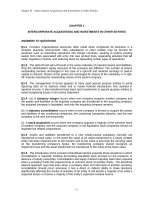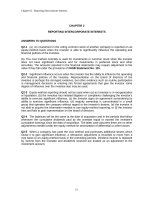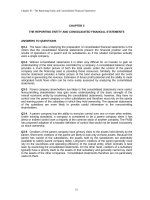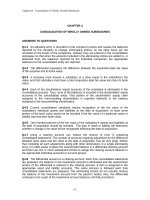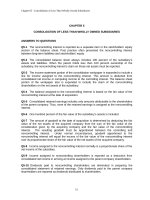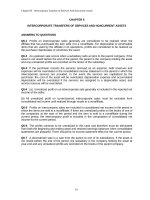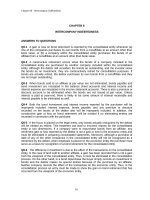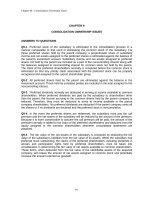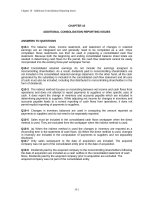Solution manual advanced financial accounting, 8th edition by baker chap005
Bạn đang xem bản rút gọn của tài liệu. Xem và tải ngay bản đầy đủ của tài liệu tại đây (378.99 KB, 125 trang )
Chapter 05 - Consolidation of Less-Than-Wholly Owned Subsidiaries
CHAPTER 5
CONSOLIDATION OF LESS-THAN-WHOLLY OWNED SUBSIDIARIES
ANSWERS TO QUESTIONS
Q5-1 The noncontrolling interest is reported as a separate item in the stockholders’ equity
section of the balance sheet. Past practice often presented the noncontrolling interest
between long-term liabilities and stockholders’ equity.
Q5-2 The consolidated balance sheet always includes 100 percent of the subsidiary’s
assets and liabilities. When the parent holds less than 100 percent ownership of the
subsidiary, the noncontrolling interest’s claim on those net assets must be reported.
Q5-3 The income statement portion of the consolidation workpaper is expanded to include a
line for income assigned to the noncontrolling interest. This amount is deducted from
consolidated net income in computing income to the controlling interest. The balance sheet
portion of the workpaper also is expanded to include the claim of the noncontrolling
shareholders on the net assets of the subsidiary.
Q5-4 The balance assigned to the noncontrolling interest is based on the fair value of the
noncontrolling interest at the date of acquisition.
Q5-5 Consolidated retained earnings includes only amounts attributable to the shareholders
of the parent company. Thus, none of the retained earnings is assigned to the noncontrolling
interest.
Q5-6 One hundred percent of the fair value of the subsidiary’s assets is included.
Q5-7 The amount of goodwill at the date of acquisition is determined by deducting the fair
value of the net assets of the acquired company from the sum of the fair value of the
consideration given by the acquiring company and the fair value of the noncontrolling
interest.
The resulting goodwill must be apportioned between the controlling and
noncontrolling interest.
Under normal circumstances, goodwill apportioned to the
noncontrolling interest will equal the excess of the fair value of the noncontrolling interest
over its proportionate share of the fair value of the net assets of the acquired company.
Q5-8 Income assigned to the noncontrolling interest normally is a proportionate share of the
net income of the subsidiary.
Q5-9 Income assigned to noncontrolling shareholders is reported as a deduction from
consolidated net income in arriving at income assigned to the parent company shareholders.
Q5-10 Dividends paid to noncontrolling shareholders are eliminated in preparing the
consolidated statement of retained earnings. Only dividends paid to the parent company
shareholders are reported as dividends distributed to shareholders.
5-1
Chapter 05 - Consolidation of Less-Than-Wholly Owned Subsidiaries
Q5-11 When the parent owns all the shares of a subsidiary (and the subsidiary has no other
publicly traded securities outstanding), it is free to decide whether it wishes to publish
separate statements for the subsidiary. In some cases creditors, regulatory boards, or other
interested parties may insist that such statements be produced. If the parent does not own
all the shares of the subsidiary, the subsidiary normally would be expected to publish
separate financial statements for distribution to the noncontrolling shareholders. In general,
the consolidated statements are published for use by parent company shareholders and are
likely to be of little use to shareholders of the subsidiary.
Q5-12 Other comprehensive income elements reported by the subsidiary must be included
in other comprehensive income in the consolidated financial statement. If the subsidiary is
not wholly owned, income assigned to the noncontrolling interest will include a proportionate
share of the subsidiary’s other comprehensive income.
Q5-13 The parent’s portion of the subsidiary’s other comprehensive income is included in
comprehensive income attributable to the controlling interest.
Q5-14 Prior to FASB 141R, the differential was computed as the difference between the fair
value of the consideration given in acquiring ownership of the subsidiary and the parent’s
portion of the book value of the subsidiary’s net assets.
Q5-15 Prior to FASB 141R, goodwill was reported as the difference between the fair value
of the consideration given in acquiring ownership of the subsidiary and the parent’s portion of
the fair value of the subsidiary’s net assets.
Q5-16 Prior to FASB 141R, consolidated net income was computed by deducting income to
noncontrolling interest from consolidated revenues less expenses.
Q5-17* The only effect of a negative balance in retained earnings is the need for a credit to
subsidiary retained earnings, rather than a debit to retained earnings, when the stockholders’
equity accounts of the subsidiary and the investment account of the parent are eliminated.
Q5-18* In the period in which the land is sold, the gain or loss recorded by the subsidiary
must be adjusted by the amount of the differential assigned to the land. When the differential
is assigned in the workpaper eliminating entries at the end of the period, a debit will be made
to the gain or loss on sale of land that came to the workpaper from the subsidiary’s books.
Q5-19A When the cost method is used, income reported by the parent and the resulting
balance in the investment account do not reflect undistributed earnings of the subsidiary
following the date of acquisition. Because these account balances are different under the
cost and equity methods, a different set of eliminating entries must be used. The major
change in eliminating entries when the cost method is adopted is that a portion of the
subsidiary retained earnings is carried forward to the consolidated total. The carryforward is
needed because the parent’s retained earnings does not include its portion of undistributed
subsidiary earnings following the acquisition, and therefore is less than consolidated retained
earnings.
5-2
Chapter 05 - Consolidation of Less-Than-Wholly Owned Subsidiaries
SOLUTIONS TO CASES
C5-1 Consolidation Workpaper Preparation
a. If the parent company is using the equity method, the elimination of the income
recognized by the parent from the subsidiary generally should not be equal to a proportionate
share of the subsidiary’s dividends. If the parent has recognized only dividend income from
the subsidiary, it is using the cost method.
b. It should be possible to tell if the preparer has included the parent's share of the
subsidiary's reported income in computing consolidated net income. It is not possible to tell
from looking at the workpaper alone whether or not all the adjustments that should have
been made for amortization of the differential or to eliminate unrealized profits have been
properly treated in computing the consolidated net income.
c. If the parent paid more than its proportionate share of the fair value of the subsidiary’s net
assets, the eliminating entries relating to that subsidiary should show amounts assigned to
individual asset accounts for fair value adjustments and to goodwill when the investment
account balance is eliminated and any noncontrolling interest is established in the
workpaper. It should be relatively easy to determine if this has occurred by examining the
consolidation workpaper.
d. If the preparer has made a separate entry in the workpaper to eliminate the change in the
parent’s investment account during the period, the easiest way to ascertain the parent’s
subsidiary ownership percentage is to determine the percentage share of the subsidiary’s
dividends eliminated in that entry. Another approach might be to divide the total amount of
the parent’s subsidiary investment account eliminated in the workpaper by the sum of the
total parent’s investment account eliminated and the total amount of the noncontrolling
interest established in the workpaper through eliminating entries. However, this approach
assumes that the fair value of the consideration given by the parent when acquiring its
subsidiary interest and the fair value of the noncontrolling interest on that date were
proportional, which is usually, by not always, the case.
5-3
Chapter 05 - Consolidation of Less-Than-Wholly Owned Subsidiaries
C5-2 Consolidated Income Presentation
MEMO
TO:
Treasurer
Standard Company
FROM:
RE:
, Accounting Staff
Allocation of Consolidated Income to Parent and Noncontrolling
Shareholders
FASB 160 specifies that consolidated net income reflects the income of the entire
consolidated entity and that consolidated net income must be allocated between the
controlling and noncontrolling interests. Earnings per share reported in the consolidated
income statement is based on the income allocated to the controlling interest only.
Consolidated net income increased by $34,000 from 20X4 to 20X5, an increase of 52
percent. However, consolidated net income allocated to the controlling interest increased by
$24,100 from 20X4 to 20X5, an increase of only 38 percent. The increase in the controlling
interest’s share of consolidated net income did not keep pace with the increase in sales
because nearly all of the sales increase was experienced by Jewel, which has a very low
profit margin. In addition the parent receives only 55 percent of the increased profits of the
subsidiary. Consolidated net income for the two years is computed and allocated as follows:
20X4
$160,000 (a)
(94,000)(c)
$ 66,000
(2,700)(e)
$ 63,300
Consolidated revenues
Operating costs
Consolidated net income
Income to noncontrolling shareholders
Income to controlling shareholders
(a)
(b)
(c)
(d)
(e)
(f)
$100,000 + $60,000
$120,000 + $280,000
($100,000 x .40) + ($60,000 x .90)
($120,000 x .40) + ($280,000 x .90)
($60,000 x .10 x .45)
($280,000 x .10 x .45)
Primary citations:
FASB 160
Secondary source:
ARB 51
5-4
20X5
$400,000 (b)
(300,000)(d)
$100,000
(12,600) (f)
$ 87,400
Chapter 05 - Consolidation of Less-Than-Wholly Owned Subsidiaries
C5-3 Pro Rata Consolidation
MEMO
To:
Financial Vice-President
Rose Corporation
From:
Re:
, Senior Accountant
Pro Rata Consolidation of Joint Venture
This memo is in response to your request for additional information on the desirability of
using pro rata consolidation rather than equity method reporting for Rose Corporation’s
investment in its joint venture with Krome Company. The equity method is used by most
companies in reporting their investments in corporate joint ventures. [APB Opinion, Par. 16]
While APB 18 provides guidance for joint ventures that have issued common stock, it does
not provide guidance for ownership of noncorporate entities. Interpretation No. 2 to APB 18
suggests that the equity method would be appropriate for unincorporated entities as well.
[APB 18, Int. #2]
Assuming the joint venture with Krome Company is unincorporated, Rose owns an undivided
interest in each asset held by the joint venture and is liable for its share of each of its
liabilities and, under certain circumstances, the entire amount. In this case, it can be argued
pro rata consolidation provides a more accurate picture of Rose’s assets and liabilities,
although not all agree with this assertion. Pro rata consolidation is generally considered not
acceptable in this country, although it is a widely used industry practice in a few industries
such as oil and gas exploration and production. If the joint venture is incorporated, Rose
does not have a direct claim on the assets of the joint venture and Rose’s liability is sheltered
by the joint venture’s corporate structure. In this case, continued use of the equity method
appears to be appropriate.
Primary citations:
APB 18
APB 18, INT #2
5-5
Chapter 05 - Consolidation of Less-Than-Wholly Owned Subsidiaries
C5-4 Elimination Procedures
a. The eliminating entries are recorded only in the consolidation workpaper and therefore do
not change the balances recorded on the company's books. Each time consolidated
statements are prepared the balances reported on the company's books serve as the starting
point. Thus, all the necessary eliminating entries must be entered in the consolidation
workpaper each time consolidated statements are prepared.
b. For acquisitions prior to the application of FASB 141R, the balance assigned to the
noncontrolling shareholders at the beginning of the period is based on the book value of the
net assets of the subsidiary at that date and is recorded in the workpaper in the entry to
eliminate the beginning stockholders' equity balances of the subsidiary and the beginning
investment account balance of the parent. For acquisitions after the effective date of FASB
141R, the noncontrolling interest at a point in time is equal to its fair value on the date of
combination, adjusted to date for a proportionate share of the undistributed earnings of the
subsidiary and the noncontrolling interest’s share of any write-off of differential. Another
approach to determining the noncontrolling interest at a point in time is to add the remaining
differential at that time to the subsidiary’s common stockholders’ equity and multiply the result
by the noncontrolling interest’s proportionate ownership interest in the subsidiary.
c. In the consolidation workpaper the ending balance assigned to noncontrolling interest is
derived by crediting noncontrolling interest for the starting balance, as indicated in the
preceding question, and then adding income assigned to the noncontrolling interest in the
consolidated income statement and deducting a pro rata portion of subsidiary dividends
declared during the period.
d. All the stockholders' equity account balances of the subsidiary must be eliminated each
time consolidated financial statements are prepared. Intercompany receivables and
payables, if any, must also be eliminated.
e. The "investment in subsidiary" and "income from subsidiary" accounts must be eliminated
each time consolidated financial statements are prepared. Intercompany receivables and
payables, if any, must also be eliminated.
5-6
Chapter 05 - Consolidation of Less-Than-Wholly Owned Subsidiaries
C5-5 Changing Accounting Standards: Monsanto Company
a. Monsanto reported the income to noncontrolling (minority) shareholders of consolidated
subsidiaries as an expense in the continuing operations portion of its 2007 income
statement.
b. Monsanto reported the noncontrolling interest in consolidated subsidiaries in other
liabilities in its consolidated balance sheet.
c. In 2007, Monsanto’s treatment of its noncontrolling interest in its consolidated financial
statements, although theoretically objectionable, was considered acceptable. The
noncontrolling (minority) interest did not fit the definition of a liability, and its share of income
did not fit the definition of an expense. Nevertheless, prior to 2008 no authoritative
pronouncement prohibited the treatment exhibited by Monsanto. With the issuance of FASB
160, however, Monsanto’s 2007 treatment became unacceptable. The noncontrolling
interest is now required to be treated as an equity item, with the income attributed to the
noncontrolling interest treated as an allocation of consolidated net income.
d. Monsanto provided customer financing through a lender that was a special purpose entity.
Monsanto had no ownership interest in the special purpose entity but did consolidate it
because Monsanto effectively originated, guaranteed, and serviced the loans. Monsanto had
a 9-percent ownership interest in one variable interest entity and a 49-percent ownership
interest in another. Neither entity was consolidated because Monsanto was not the primary
beneficiary of either entity.
5-7
Chapter 05 - Consolidation of Less-Than-Wholly Owned Subsidiaries
SOLUTIONS TO EXERCISES
E5-1 Multiple-Choice Questions on Consolidation Process
1. d
2. d
3. b
4. d [AICPA Adapted]
E5-2 Multiple-Choice Questions on Consolidation [AICPA Adapted]
1. b
2. c
3. a
$650,000 = $500,000 + $200,000 - $50,000
4. c
$95,000 = ($956,000 / .80) - $1,000,000 - $100,000
5. c
$251,000 = .20[($956,000 + $239,000) + ($190,000 - $5,000 - $125,000)]
5-8
Chapter 05 - Consolidation of Less-Than-Wholly Owned Subsidiaries
E5-3 Eliminating Entries with Differential
a. Eliminating entries:
E(1) Common Stock – Amber Company
Retained Earnings
Differential
Investment in Amber Company Stock
Noncontrolling Interest
20,000
37,000
25,000
Computation of differential
Fair value of the consideration given by Game Corp.
Fair value of noncontrolling interest
Total fair value
Book value of Amber’s net assets ($85,000 - $28,000)
Differential
E(2) Inventory
Buildings and Equipment (net)
Differential
$5,000 = $25,000 - $20,000
$20,000 = $70,000 - $50,000
b.
49,200
32,800
$49,200
32,800
$82,000
(57,000)
$25,000
5,000
20,000
25,000
Journal entries used to record transactions, adjust account balances, and close
income and revenue accounts at the end of the period are recorded in the company's
books and change the reported balances. On the other hand, eliminating entries are
entered only in the consolidation workpaper to facilitate the preparation of consolidated
financial statements. As a result, they do not change the balances recorded in the
company's accounts and must be reentered each time a consolidation workpaper is
prepared.
5-9
Chapter 05 - Consolidation of Less-Than-Wholly Owned Subsidiaries
E5-4 Computation of Consolidated Balances
a. Inventory
$140,000
b. Land
$ 60,000
c.
$550,000
Buildings and Equipment
d. Fair value of consideration given by Ford
Fair value of noncontrolling interest
Total fair value
Book value of Slim’s net assets
Fair value increment for:
Inventory
Land
Buildings and equipment (net)
Fair value of identifiable net assets
Goodwill
$450,000
20,000
(10,000)
70,000
$470,000
117,500
$587,500
(530,000)
$ 57,500
e. Investment in Slim Corporation: None would be reported;
the balance in the investment account is eliminated.
f.
Noncontrolling Interest ($587,500 x .20)
5-10
$117,500
Chapter 05 - Consolidation of Less-Than-Wholly Owned Subsidiaries
E5-5 Balance Sheet Workpaper
Power Company and Pleasantdale Dairy
Consolidated Balance Sheet Workpaper
January 1, 20X7
Item
Cash and Receivables
Inventory
Land
Buildings and
Equipment (net)
Investment in
Pleasantdale Stock
Differential
Total Debits
Current Payables
Long-Term Liabilities
Common Stock
Power Company
Pleasantdale Dairy
Retained Earnings
Noncontrolling Interest
Total Credits
PleasPower antdale
Company
Dairy
130,000
70,000
210,000
90,000
70,000
40,000
390,000
Adjustments and
Eliminations
Debit
Credit
(a)
900
(3) 8,900
(2) 20,000
220,000
270,000
610,000
(1) 20,000
1,070,000
420,000
80,000
200,000
40,000
100,000
(3)
390,000
60,000
220,000
(1) 60,000
(1)220,000
1,070,000
420,000
329,800
400,000
Consolidated
192,000
300,000
130,000
(1)270,000
(2) 20,000
8,900
1,232,000
111,100
300,000
400,000
(a)
900
(1) 30,000
329,800
390,900
30,000
1,232,000
Adjusting and eliminating entries:
(a) Cash and Receivables
Retained Earnings
Accrue interest earned by Power Company.
E(1) Common Stock – Pleasantdale Dairy
Retained Earnings
Differential
Investment in Pleasantdale Dairy Stock
Noncontrolling Interest
Eliminate investment balance.
$20,000 = $270,000 + $30,000 - $280,000
E(2) Land
Differential
Assign differential.
900
60,000
220,000
20,000
20,000
E(3) Current Payables
Cash and Receivables
Eliminate intercompany receivable/payable.
5-11
8,900
900
270,000
30,000
20,000
8,900
Solutions Manual – Baker / Lembke / King / Jeffrey, Advanced Financial Accounting, 7e
5 - 12
Chapter 05 - Consolidation of Less-Than-Wholly Owned Subsidiaries
E5-6 Majority-Owned Subsidiary Acquired at Greater than Book Value
a. Eliminating entries:
E(1) Common Stock – Down Corporation
Retained Earnings
Differential
Investment in Down Corporation Stock
Noncontrolling Interest
Eliminate investment balance:
$21,000 = $102,200 + $43,800 - $125,000
40,000
85,000
21,000
E(2) Inventory
Buildings and Equipment
Differential
Assign differential.
6,000
15,000
E(3) Accounts Payable
Accounts Receivable
Eliminate intercompany receivable/payable.
12,500
5-13
102,200
43,800
21,000
12,500
Chapter 05 - Consolidation of Less-Than-Wholly Owned Subsidiaries
E5-6 (continued)
Zenith Corporation and Down Corporation
Consolidated Balance Sheet Workpaper
December 31, 20X4
b.
Item
Zenith
Corp.
Down
Corp.
Cash
Accounts Receivable
Inventory
Land
Buildings and Equipment
Investment in Down
Corporation Stock
Differential
Total Debits
50,300 21,000
90,000 44,000
130,000 75,000
60,000 30,000
410,000 250,000
Accumulated Depreciation
Accounts Payable
Mortgage Payable
Common Stock
Zenith Corporation
Down Corporation
Retained Earnings
Noncontrolling Interest
Total Credits
150,000 80,000
152,500 35,000
250,000 180,000
c.
102,200
842,500 420,000
80,000
Eliminations
Debit
Credit
(2) 6,000
(2) 15,000
(1)102,200
(2) 21,000
(1) 21,000
(1) 40,000
(1) 85,000
842,500 420,000
179,500
71,300
121,500
211,000
90,000
675,000
1,168,800
230,000
175,000
430,000
80,000
(3) 12,500
40,000
85,000
210,000
(3) 12,500
Consolidated
(1) 43,800
179,500
210,000
43,800
1,168,800
Zenith Corporation and Subsidiary
Consolidated Balance Sheet
December 31, 20X4
Cash
Accounts Receivable
Inventory
Land
Buildings and Equipment
Less: Accumulated Depreciation
Total Assets
$675,000
(230,000)
Accounts Payable
Mortgage Payable
Stockholders’ Equity:
Controlling Interest:
Common Stock
Retained Earnings
Total Controlling Interest
Noncontrolling Interest
Total Stockholders’ Equity
Total Liabilities and Stockholders' Equity
5-14
$ 71,300
121,500
211,000
90,000
445,000
$938,800
$175,000
430,000
$ 80,000
210,000
$290,000
43,800
333,800
$938,800
Chapter 05 - Consolidation of Less-Than-Wholly Owned Subsidiaries
E5-7 Consolidation with Minority Interest
Eliminating entries:
E(1) Common Stock – Dynamic Corporation
Retained Earnings
Differential
Investment in Dynamic Corporation Stock
Noncontrolling Interest
Eliminate investment balance:
$160,000 = $390,000 + $130,000 – ($120,000 +
$240,000)
$130,000 = $520,000 x .25
E(2) Buildings
Inventories
Goodwill
Differential
Assign differential:
$44,000 = $160,000 - $80,000 - $36,000
120,000
240,000
160,000
80,000
36,000
44,000
390,000
130,000
160,000
E5-8 Workpaper for Majority-Owned Subsidiary
a.
Eliminating entry:
E(1) Common Stock – Lowtide Builders
Retained Earnings
Investment in Lowtide Builders Stock
Noncontrolling Interest
Eliminate investment balance.
5-15
140,000
10,000
90,000
60,000
Chapter 05 - Consolidation of Less-Than-Wholly Owned Subsidiaries
E5-8 (continued)
b.
Glitter Enterprises and Lowtide Builders
Consolidated Balance Sheet Workpaper
January 1, 20X5
Glitter
Enterprises
Lowtide
Builders
Cash and Receivables
Inventory
Buildings and
Equipment (net)
Investment in
Lowtide Stock
Total Debits
80,000
150,000
30,000
350,000
110,000
500,000
430,000
80,000
510,000
90,000
750,000
460,000
Current Liabilities
Long-Term Debt
Common Stock
Glitter
Lowtide
Retained Earnings
Noncontrolling
Interest
Total Credits
100,000
400,000
110,000
200,000
c.
Glitter Enterprises and Subsidiary
Consolidated Balance Sheet
January 1, 20X5
Item
200,000
50,000
750,000
Eliminations
Debit
Credit
(1) 90,000
1,120,000
210,000
600,000
200,000
140,000 (1)140,000
10,000 (1) 10,000
460,000
Consolidated
50,000
150,000
(1) 60,000
150,000
60,000
1,120,000
Cash and Receivables
Inventory
Buildings and Equipment (net)
Total Assets
$ 110,000
500,000
510,000
$1,120,000
Current Liabilities
Long-Term Debt
Stockholders’ Equity:
Controlling Interest:
Common Stock
Retained Earnings
Total Controlling Interest
Noncontrolling Interest
Total Stockholders’ Equity
Total Liabilities and Stockholders' Equity
$ 210,000
600,000
5-16
$200,000
50,000
$250,000
60,000
310,000
$1,120,000
Chapter 05 - Consolidation of Less-Than-Wholly Owned Subsidiaries
E5-9 Multiple-Choice Questions on Balance Sheet Consolidation
1.
d
$215,000
=
$130,000 + $70,000 + ($85,000 - $70,000)
2.
c
$40,000
=
($150,500 + $64,500) - ($405,000 - $28,000 - $37,000
- $200,000) - $15,000 - $20,000
3.
b
$1,121,000
=
Total Assets of Power Corp.
Less: Investment in Silk Corp.
Book value of assets of Silk Corp.
Book value reported by Power and
Silk
Increase in inventory ($85,000 - $70,000)
Increase in land ($45,000 - $25,000)
Goodwill
Total assets reported
4.
d
$701,500
5.
d
$64,500
6.
d
7.
c
$ 791,500
(150,500)
$ 641,000
405,000
$1,046,000
15,000
20,000
40,000
$1,121,000
=
($61,500 + $95,000 + $280,000) + ($28,000 + $37,000
+ $200,000)
$205,000
=
The amount reported by Power Corporation
$419,500
=
($150,000 + $205,000) + $64,500
5-17
Chapter 05 - Consolidation of Less-Than-Wholly Owned Subsidiaries
E5-10 Basic Consolidation Entries for Majority-Owned Subsidiary
a.
Journal entries recorded by Horrigan Corporation:
(1) Investment in Farmstead Company Stock
Cash
Record purchase of Farmstead Company Stock.
(2) Cash
Investment in Farmstead Company Stock
Record dividends from Farmstead Company.
(3) Investment in Farmstead Company Stock
Income from Subsidiary
Record equity-method income.
b.
210,000
3,500
14,000
210,000
3,500
14,000
Eliminating entries:
E(1) Income from Subsidiary
Dividends Declared
Investment in Farmstead Company Stock
Eliminate income from subsidiary.
E(2) Income to Noncontrolling Interest
Dividends Declared
Noncontrolling Interest
Assign income to noncontrolling interest.
E(3) Common Stock — Farmstead Company
Retained Earnings, January 1
Investment in Farmstead Company Stock
Noncontrolling Interest
Eliminate investment balance.
5-18
14,000
6,000
100,000
200,000
3,500
10,500
1,500
4,500
210,000
90,000
Chapter 05 - Consolidation of Less-Than-Wholly Owned Subsidiaries
E5-11 Majority-Owned Subsidiary with Differential
a.
Journal entries recorded by West Corporation:
(1) Investment in Canton Corporation Stock
Cash
Record investment.
(2) Cash
Investment in Canton Corporation Stock
Record dividends from Canton Corporation:
$9,000 = $12,000 x .75
(3) Investment in Canton Corporation Stock
Income from Subsidiary
Record equity-method income:
$22,500 = $30,000 x .75
(4) Income from Subsidiary
Investment in Canton Corporation Stock
Amortize differential assigned to equipment:
$3,000 = ($28,000 / 7 years) x .75
b.
133,500
9,000
22,500
3,000
133,500
9,000
22,500
3,000
Eliminating entries December 31, 20X3:
E(1) Income from Subsidiary
Dividends Declared
Investment in Canton Corporation Stock
Eliminate income from subsidiary.
E(2) Income to Noncontrolling Interest
Dividends Declared
Noncontrolling Interest
Assign income to noncontrolling interest:
$6,500 = ($30,000 - $4,000) x .25
$3,000 = $12,000 x .25
19,500
6,500
E(3) Common Stock — Canton Corporation
Retained Earnings, January 1
Differential
Investment in Canton Corporation Stock
Noncontrolling Interest
Eliminate beginning investment balance:
$28,000 = ($133,500 + $44,500) – $150,000
60,000
90,000
28,000
E(4) Equipment
Differential
Assign beginning differential.
28,000
E(5) Depreciation Expense
Accumulated Depreciation
Amortize differential related to equipment:
$4,000 = $28,000 / 7 years
5-19
4,000
9,000
10,500
3,000
3,500
133,500
44,500
28,000
4,000
Chapter 05 - Consolidation of Less-Than-Wholly Owned Subsidiaries
5-20
Chapter 05 - Consolidation of Less-Than-Wholly Owned Subsidiaries
E5-12 Differential Assigned to Amortizable Asset
a.
b.
Lancaster Company’s common stock, January 1, 20X1
Lancaster Company’s retained earnings, January 1, 20X1
Book value of Lancaster’s net assets
Proportion of stock acquired
Book value of Lancaster's shares purchased
by Major Corporation
Excess of acquisition price over book value
Fair value of consideration given
Add: Share of Lancaster's net income ($60,000 x .90)
Less: Amortization of patents ($40,000 / 5) x .90
Dividends paid by Lancaster ($20,000 x .90)
Balance in investment account, December 31, 20X1
$120,000
380,000
$500,000
x
.90
$450,000
36,000
$486,000
54,000
(7,200)
(18,000)
$514,800
Eliminating entries, December 31, 20X1:
E(1)
Income from Subsidiary
Dividends Declared
Investment in Lancaster Company Stock
Eliminate income from subsidiary:
$46,800 = ($60,000 x .90) – ($8,000 x .90)
E(2)
Income to Noncontrolling Interest
Dividends Declared
Noncontrolling Interest
Assign income to noncontrolling interest:
$5,200 = ($60,000 - $8,000) x .10
$2,000 = $20,000 x .10
E(3)
Common Stock — Lancaster Company
Retained Earnings, January 1
Differential
Investment in Lancaster Company Stock
Noncontrolling Interest
Eliminate investment balance:
$40,000 = ($486,000 + $54,000) - $500,000
E(4)
Patents
Differential
Assign differential.
E(5)
Amortization Expense
Patents
Amortize differential related to patents.
46,800
5,200
120,000
380,000
40,000
40,000
5-21
8,000
18,000
28,800
2,000
3,200
486,000
54,000
40,000
8,000
Chapter 05 - Consolidation of Less-Than-Wholly Owned Subsidiaries
E5-13 Consolidation after One Year of Ownership
a.
Eliminating entries, January 1, 20X2:
E(1)
Common Stock — Lowe Corporation
Retained Earnings, January 1
Differential
Investment in Lowe Corporation Stock
Noncontrolling Interest
Eliminate investment balance.
Computation of differential
Fair value of consideration given by Pioneer
Fair value of noncontrolling interest
Total fair value
Underlying book value
Differential
E(2)
b.
Buildings
Goodwill
Differential
Assign differential:
$5,500 = $37,500 - $32,000
120,000
80,000
37,500
190,000
47,500
$190,000
47,500
237,500
(200,000)
$ 37,500
32,000
5,500
37,500
Eliminating entries, December 31, 20X2:
E(1)
Income from Subsidiary
Investment in Lowe Corporation Stock
Eliminate income from subsidiary.
Computation of income from subsidiary
Reported net income of Lowe
Amortization of differential assigned to
buildings ($32,000 / 8 years)
Income after amortization of differential
Proportion of stock acquired
Income from subsidiary for 20X2
5-22
28,800
$40,000
(4,000)
$36,000
x
.80
$28,800
28,800
Chapter 05 - Consolidation of Less-Than-Wholly Owned Subsidiaries
E5-13 (continued)
E(2)
Income to Noncontrolling Interest
Noncontrolling Interest
Assign income to noncontrolling interest:
$7,200 = ($40,000 - $4,000) x .20
7,200
E(3)
Common Stock — Lowe Corporation
Retained Earnings, January 1
Differential
Investment in Lowe Corporation Stock
Noncontrolling Interest
Eliminate beginning investment balance.
120,000
80,000
37,500
E(4)
E(5)
Buildings
Goodwill
Differential
Assign beginning differential.
32,000
5,500
Depreciation Expense
Accumulated Depreciation
Amortize differential.
4,000
5-23
7,200
190,000
47,500
37,500
4,000
E5-14 Consolidation Following Three Years of Ownership
a.
Computation of increase in value of patents:
Fair value of consideration given by Knox
Fair value of noncontrolling interest
Total fair value
Book value of Conway stock
Excess of fair value over book value
Increase in value of land ($30,000 - $22,500)
Increase in value of equipment ($360,000 - $320,000)
Increase In value of patents
b.
E(1)
E(2)
c.
$277,500
185,000
$462,500
(400,000)
$ 62,500
(7,500)
(40,000)
$ 15,000
Common Stock — Conway Company
250,000
Retained Earnings
150,000
Differential
62,500
Investment in Conway Company Stock
Noncontrolling Interest
Eliminate investment balance:
$62,500 = ($277,500 + $185,000) – ($250,000 + $150,000)
Land
Equipment
Patents
Differential
Assign differential.
7,500
40,000
15,000
62,500
Computation of investment account balance at January 1, 20X9:
Fair value of consideration given
Undistributed income since acquisition
($100,000 - $60,000) x .60
Amortization of differential assigned to:
Equipment ($40,000 / 8) x .60 x 2 years
Patents ($15,000 / 10) x .60 x 2 years
Account balance at January 1, 20X9
d.
277,500
185,000
$277,500
24,000
(6,000)
(1,800)
$293,700
Entries recorded by Knox during 20X9:
(1)
(2)
(3)
Cash
Investment in Conway Company Stock
Record dividends from subsidiary.
Investment in Conway Company Stock
Income from Subsidiary
Record equity-method income.
Income from Subsidiary
Investment in Conway Company Stock
Amortize differential:
6,000
6,000
18,000
18,000
3,900
3,900
